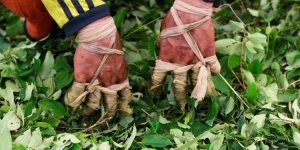
Can Colombia Legitimize its Coca Trade?

BusinessInsider.com The wrapped fingers of a raspachin worker who collects coca leaves, during the harvest on a small coca farm in Guaviare province, Colombia. REUTERS/John Vizcaino
For the past century, Colombia has been embroiled in an intense war on drugs which has created a steady state of violent conflict within the country, and little impact on long-term production or drug use. This war has largely been financed by the United States. Complicating the drug war is another long-standing conflict with leftist guerrillas who have control of territory with a high density of coca plants. This piece will focus on the problems of the Colombian approach to the war on drugs and how it can be adapted into more workable solutions in the future.
At the height of their power, the drug cartels controlled Colombia, with Pablo Escobar becoming the 7th richest person in the world.
They supplied 80% of the global cocaine market. Much of the demand for cocaine came from the U.S., prompting the U.S. government and Drug Enforcement Administration (DEA) to take action. They then sent money, supplies, and even agents to Colombia as a way to disrupt the drug production, and distribution to North America. Through a long and bloody process, which included murder, arrests, and extradition requests, the DEA and Colombian government were able to dismantle the drug cartels in Colombia.
Unfortunately, this only partially resolved the sourcing issue and did nothing to address the demand issue. While the DEA and Colombian government were able to curb the cartels’ flow of drugs from Colombia to the U.S., other sources stepped in and continued the supply. Thus, the actions of the DEA did nothing to address the demand for cocaine in the U.S. The DEA and Colombian government were also ineffective in transitioning out of the drug war and providing an environment in which those previously involved in the drug trade could otherwise make a living. There were many promises by the Colombian government to help the farmers replace their coca crops with legal commodities, unfortunately, the help never came. The government failed to adequately support these farmers with seeds and other farming assistance, so the farmers quickly went back to cultivating the coca crops. The farmers needed to support their families, and no alternatives were offered. An example of that is Wilmer Ovalle, a young man that is taking over his father’s coca cultivation in the absence of state support for other crops. Ovalle knows that with the coca crop he will have a steady income and the drug trade will go on, even if large cartels have been broken up. (https://www.theguardian.com/world/2016/apr/18/colombia-united-nations-assembly-war-on-drugs)
In an effort to diminish the supply, the DEA ran fumigation operations in which they used agricultural planes to spray herbicide over the Colombian countryside killing the cocaine crops.
Similar to the violent oppression of the cartels, the spraying forced the growers to adapt, and many moved deeper into territory controlled by the guerrillas. Ovalle’s father moved their family plantations to Colombian natural reserves, where the fumigations were prohibited. The farmers cut down trees and planted their coca in the Colombian tropical forest, exacerbating deforestation issues.
There was a glimmer of hope for Colombia with the accession to power of Juan Manuel Santos, who promised a more community-based approach to the drug war, as well as signing a peace deal with the FARC guerrillas, which includes a workable, sustainable solution to the illicit drug business. However, like too many things in Colombia, the policy rhetoric often differs from practice and implementation, thus the war on drugs continues. With the political damage following the failures of the FARC peace deal, Santos had to leave office and was replaced by his opposition.
In order to stop the unnecessary violence and suffering from this two-front conflict, Colombia must dedicate itself to a community-based approach.
One which helps farmers shift their production from coca to food and other crops which are profitable. The government needs to help the farmers make the transition as part of a post-conflict solution which places farmers at the center of the solution. Historically, farmers have shown willingness to cooperate, as they are concerned with the violence perpetuated by illicit drug trade as well as health impacts of coca farming. However, the government must show the political will to follow through and help the farmers. This might require farming support, subsidies, or tax incentives until the farmers are able to produce a significant yield of legal crops which can support their families and communities. The international community must also act to condemn the war on drugs, assist with community-based post-conflict practices, and look for other sustainable solutions to this conflict. The war on drugs failed miserably for both Colombia and the U.S., as production rates and prices for coca remain strong, as does drug use in the U.S.
~ Roberto Malta is a Brazilian born, George Mason University student pursuing a B.A. in Global Affairs, with minors in History and Economics
